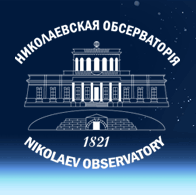|
2010-09-20 17:46:06
Early studies History of study the sector of Solar System bodies can be started from 1959. Nikolaev observatory received a reconstituted zone astrograph from Pulkovo. This instrument was used for observations of small planets to -20 ° in declination for 3 minutes. The initiator of idea was A.N. Deich, the head of the photographic astrometry department in Pulkovo Observatory. In 1960 a cylindrical tower with a rotating dome (diameter - 5 meters) was built to install the telescope. It was fully installed in the first half of January 1961, and since spring 1961 the photographic observations of large and small planets were started. The results of study lens of zonal astrograph, which was made by F.F. Kalihevich, showed the asymmetry of stellar images. It was extremely harmful for astrometric work. In 1964 the lens was removed and adjusted by the famous optician Dmitry D. Maksutov in Pulkovo Observatory. As a result, the lens supplied a good quality of stars images and determinate objects up to 12 magnitude for 3 minutes of exposure time. The observations of Venus, Mars, Jupiter, Saturn and Uranus and Neptune were included to the program of large planets observations. The initial program of observations of selected minor planets had been prepared in accordance with B.V. Numerov plan (1932): Observations of 10 selected minor planets (Ceres (1), Pallas (2), Juno (3), West (4), Hebe (6), Iris (7), Parfenopa (11), Melpomene (18), Laetitia (39), Harmony (40)) for determination of the position of coordinate origin (the vernal point) and the equator of fundamental catalog of faint stars. On 1961-1970, there were obtained 735 plates using the astrograph, and 644 were processed. The processing results were published in the Proceedings of the GAO of USSR and the PTA bulletin. Later, the lists of minor planets were expanded to 20, and then there were added 15 minor planets brighter than 12 magnitude, according the program suggested by Yu.V. Batrakov and V.A. Shor. In 1961-1996, the observation of 19 selected asteroids were carried out using zonal astrograph in order to improve the fundamental catalog and to determine the orientation of its axes towards the axes of dynamic system of coordinates. According to the results of observations there was obtained a catalogue of 2450 asteroids positions. It was represented in the Minor Planet Center of IAU. Photographic observations using zone astrograph lasted for 37 years and were completed in May 31, 1999, because of the lack of photographic plates. The glass library of astrograph contained 200 photographic plates of the polar zone, obtained in 1929-1931, and more than 8,700 plates obtained during the period from 1961 to 1999. Also the library included exact positions of the major planets (except Mercury and Pluto), Galilean Jupiter's moons, Saturn's brightest satellite, selected minor planets and comets. In addition, it included observations for other programs, for example, zodiac and equatorial catalogs, polar zone, areas with radio sources, multiple star systems, etc. Modern research In 1999, a CCD camera in the focal plane of zonal astrograph, made in NAO, was installed . Lately the guide telescope was equipped with a television camera as well. As the result, the Zonal Astrograph have got the name of "the multi-channel telescope”. Modern astrometric accuracy of the ground-based observations of asteroids with an accidental error of 0.05, is sufficient to detect deviations of more than 0.1" in their movement. Considering that asteroids belong to the class of small Solar system bodies their movement is very sensitive to various perturbations. One of these factors is the gravitational perturbations to all bodies in the Solar system from the side of asteroids with big masses. To solve this problem the positional CCD observations of asteroids were started according to a joint research program (Nikolaev Observatory, Institute of Applied Astronomy and Observatory in Bordeaux (France)). In 2000-2001, the experimental observations were carried out, with a purpose to develop the method, but results were not published. In 2002-2005, the catalog of 622 positions for 24 asteroids up to 13 magnitude in ICRS system was obtained. It was used to solve the problem of determining masses of large asteroids on the basis of ground-based observations. Since 2004, the sector of Solar system body cooperates with Turkish National Observatory TUBITAK, located on Mount Bakyrlytepe, and with Astronomical Observatory of Kazan State University. Since 2006 sector cooperates with the Institute of Celestial Mechanics and Ephemeris calculation in the Paris Observatory. Nowadays, RI NAO is going to take part in the program of a ground-based support for the future European space mission GAIA in the field of study of asteroids movements. Our achievements The photographic positional astrometric observations obtained with the Zonal Astrograph in 1961-1997 has been used by the Jet Propulsion Laboratory (JPL, USA) to construct ephemerides of the Sun, eight major planets, Pluto and the Moon since 2003, when DE409 was released. The catalogue of 2450 photographic positions of minor planets, obtained in 1961-1996, was placed in the database of the Minor Planet Center (MPC) of the IAU. These observations have received the highest estimation for their small accidental and systematic errors in the positions of asteroids. Each year of observations of this period is designated by the letter «h» (high-precision astrometry). Observations of asteroids in 2002, 2003 and 2005 were also marked with «h» according to the information from the MPC.
Literature:
1. Калихевич Ф.Ф. Установка и исследование зонного астрографа в Николаеве. Первые результаты наблюдений планет: Дис. ... кан. физ.-мат. наук: 01.03.01. − Николаев, 1970. − 144 с. |

Науково-дослідний інститут
Миколаївська астрономічна обсерваторія
Міністерство освіти і науки
Миколаївська астрономічна обсерваторія
Міністерство освіти і науки

 |
 |
 |